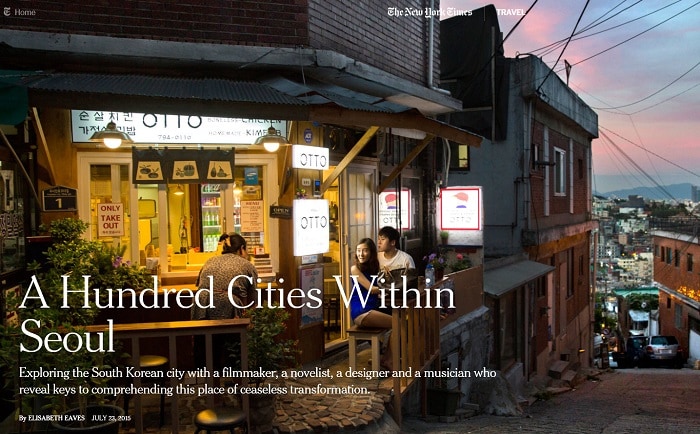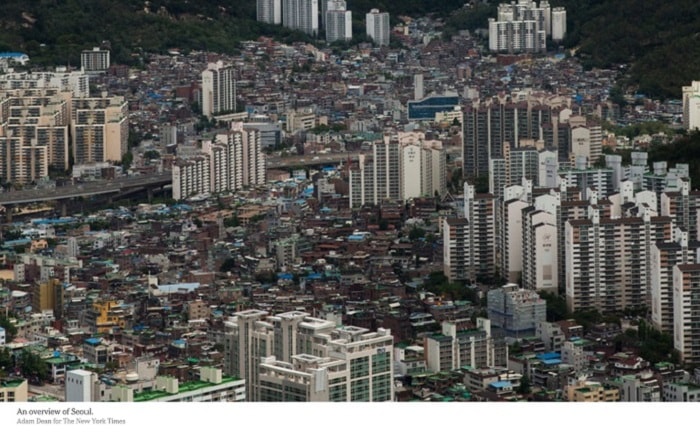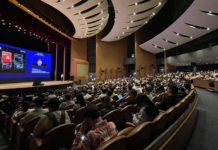The New York Times (NYT) recently garnered some attention with an article that shed light on various different aspects of Seoul.
Elisabeth Eaves, a NYT writer, shared her travel experiences in the capital city in her July 23 article, “A Hundred Cities Within Seoul.”
“Seoul is the heart of an urban area of more than 25 million people, among the largest in the world,” Eaves said. “If you look down from the top of N Seoul Tower [the tower atop Namsan Mountain], there could be hundreds of Seouls, and I didn’t know which to choose.”

The NYT article ‘A Hundred Cities Within Seoul’ is published in its travel section on July 23.
The writer asked several well-known Seoul-based artists to show her a part of Seoul that inspired them or that held special meaning for them. The artists she met were filmmaker Bong Joon-ho, novelist Shin Kyung-sook, fashion designer Lee Ju-young and guitarist Kim Se-hwang.
The filmmaker took her to one of his favorite neighborhoods, Usadan-ro. “This part of Seoul is amazing,” Bong said, as the pair looked out over the city from a bench. For Bong, the Usadan neighborhood is a testament to “the incoherence of a city that doesn’t have strong continuity.”
The author described the sights unfolding in front of them that they were sharing, as she wrote, “In the foreground were old houses, then a church steeple in the middle distance. Beyond lay the Han River and too many high-rises to count.” She continued to quote Bong as saying, “In five or 10 years, these old houses will be gone. This is a city of destruction and reconstruction.”
The city is not always subject to “frenetic evolution,” Eaves said. She spotlighted another part of Seoul that feels like, “serene oases,” too. The encounter with best-selling novelist Shin Kyung-sook took place at the Leeum, Samsung Museum of Art in Hannam-dong, a museum that is home to a range of ancient celadon works of pottery and white porcelain jars dating back to Goryeo (918-1392) and Joseon (1392-1910) times.
Shin explained that whenever she was under stress she tried to find peace by visiting the museum. The novelist shared Bong’s view, in terms of the rapid transformation of the city. “In Paris or New York, when you have an appointment with a friend, you can meet her in the same place that you did a year ago. In Seoul, you can’t, because there will be something new there.” She pointed out two factors behind the transformation: “The city’s dynamism and energy.”

A slice of Seoul, as seen by NYT writer Elisabeth Eaves.
During her time in Seoul, the NYT writer also hit Gangnam-gu District, a borough that became famous when singer Psy sparked a global sensation with his song “Gangnam Style.” There, she met with clothing designer Lee Ju-young who runs her “Resurrection” showroom in the posh neighborhood of Cheongdam-dong.
During her talk with Eaves, Lee shared an amusing anecdote from her career. Ten years ago, Lee seized the opportunity to present some of her designs to Marilyn Manson on his visit to Seoul for a concert. Just a few minutes later, Manson called her and asked for more clothes to wear. The singer has, the designer said, become one of her biggest influences.
The last few paragraphs of the NYT article were taken up by a trip to the neighborhood of Samcheong-dong, home to traditional Hanok buildings. Guitarist Kim Se-hwang and movie producer Jimi Nam welcomed the writer there, giving her a chance to taste a series of traditional Korean food items, from marinated beef ribs, tteokkalbi, and tofu with kimchi through to North Korean-style dumplings and spicy rice cake, known as tteokbokki.
As for Samcheong-dong, a neighborhood where traditional houses have been kept intact, the writer said that it, too, has undergone modernization, just as other areas have, but that this time it was a different, more gracious kind of modernization.
“It is still home to many Hanok homes, with wooden frames and curving roof tiles. Most are no longer the homes they once were, but have been restored in keeping with their original design, and repurposed as shops, teahouses and restaurants.”
By Sohn JiAe
Korea.net Staff Writer
jiae5853@korea.kr























